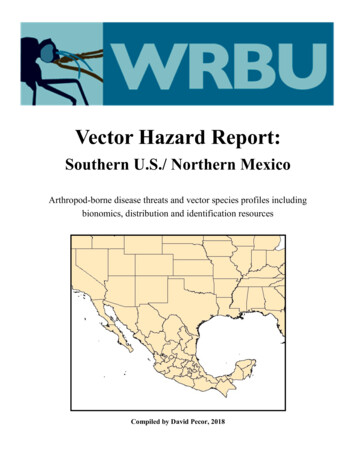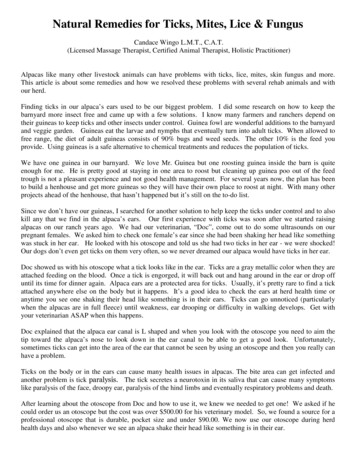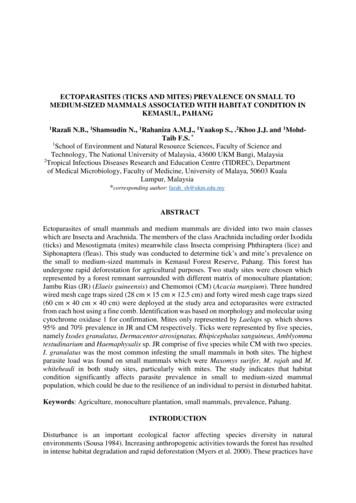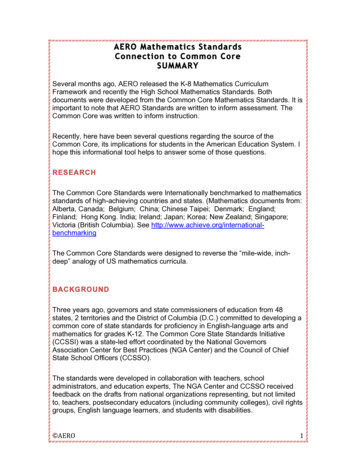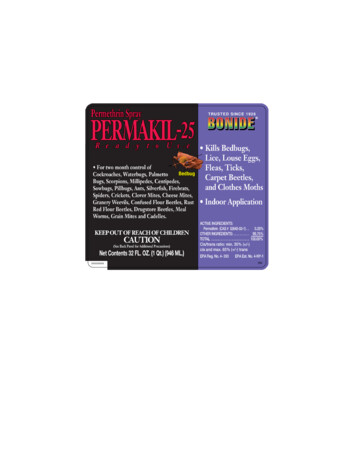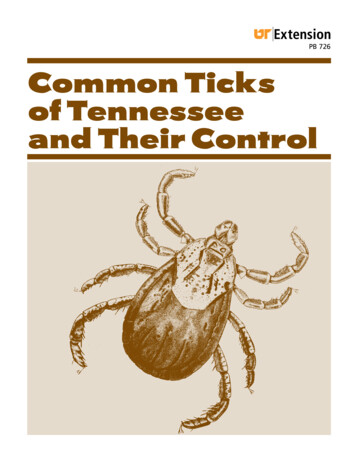
Transcription
PB 726Common Ticksof Tennesseeand Their Control
Common Ticksof Tennesseeand Their ControlReid R. Gerhardt, Professor, Karen M. Vail, Associate Professor, Harry E. Williams, former Professor Emeritus,Entomology and Plant Pathology, and John New, Professor, College of Veterinary MedicineTicks are external parasites of mammals,birds and reptiles and feed only on theblood of their hosts. They can be distinguished from insects and spiders because the head,thorax and abdomen are fused into a single, sac-likebody region. They have four pairs of jointed legs andno antennae. Ticks are found walking on or attachedto their hosts or in areas frequented by their hosts.These areas include woodlands, weedy or brushyFigure 1.Developmental stages of American dog tick.Drawing courtesy of the Dept. Of Health, Education and Welfare,Public Health Service, Center for Disease Control, Atlanta, GA. areas, lawns, dog kennels and dog runs. Ticksfrequently wait for a host on vegetation along trailsand paths traveled by people or animals.Life cycleAll of the common ticks of Tennessee havefour life stages — egg, larva, nymph and adult(Figure 1). Each of the stages, other than the egg,requires a separate animal host to complete its
a.d evelopment, which, all together, may be two orthree years long. Each blood-engorged female leavesher host animal and lays a single mass of 3,000 to6,000 eggs. The eggs hatch into larvae about 1/40thof an inch long with three pairs of legs. Immediatelyafter hatching, the larvae climb onto the nearest vegetation and wait for an animal to pass by. They graspthe hair or feathers of the passing animal and attachthemselves by inserting their mouthparts into theskin. They remain attached for several days and takein blood until they are greatly distended. After theyare full of blood, they drop off the host and molt tothe eight-legged nymph. Nymphs usually overwinterand follow the same feeding process the next year.After feeding, they drop off again and molt to adultmales and females. The adults usually overwinter andemerge in the spring to find the third host. Matingoccurs on this host. When the female is full of blood,she detaches and lays her eggs. Adult, engorged females can grow to more than one-half inch.Kinds of ticksb.c.Figure 2.Common ticks found in recreation areas and around homes inTennessee are (a) the American dog tick, (b) the lone star tickand (c) the brown dog tick.Adult females are shown.Drawings are courtesy of USDA/ARS Manual on Livestock Ticks.Three kinds of ticks are frequently encounteredaround homes or in recreation areas in Tennessee.These are the American dog tick, lone star tick andthe brown dog tick (Figure 2).The American dog tick (Dermacentor variabilis) is a dark brown tick that can be identified bythe randomly arranged silver streaks on the back ofboth the male and female. The immature stages feedprimarily on rodents, rabbits, opossums, raccoons,etc., but never on humans. Adults are found on largeranimals such as dogs, cattle, deer and humans. TheAmerican dog tick is the species that can transmit theRocky Mountain Spotted Fever organism in Tennessee. Fortunately, only 3 to 5 percent of adult ticks inknown Rocky Mountain Spotted Fever areas carrythe organism. This tick attaches to humans mostfrequently in the spring and early summer. Resultsof a survey conducted by University of Tennessee researchers and Extension faculty indicate that American dog (Figure 3) and lone star ticks (Figure 4) arewell-distributed throughout the state.The lone star tick (Amblyomma americanum)is a reddish brown tick that is slightly smaller thanthe American dog tick. These ticks have long, largesnouts and both sexes have pale markings on thebacks. The adult female has a conspicuous white
anWUn oreLincolnRoaneVBu anrendsoeRheaMeigsBedford CoffeeAWhite CumberlandmiGilesehRutonnnCa WarrenrndeBlephreWayneMcNairy JHademanHaPerrySmithClaiborne HancockHawkinsllebermp UnionngCanileabGreeneGr sson OvertonDeKalbWilliamsonMarshallndeod Madison stonPickettClayMaconRobertson SumnerCheathamMontgomeryObion Weakley nnGrundynBedford CoffeeAWhite CumberlandltoehRutonnnCa WarrenrndeBledrforMorganPutnamSullivanUnJVBu anrendsoeRheaMeigsSmithClaiborne HancockHawkinsllebermp UnionngCanileabGreeneGr HamsonScottackmiGilesWilsonFentressson vidsonMarsysphreHickmanLawMcNairy HardinHumtonFayetteHarShelbyHandeod Madison ttClayMaconRobertson SumnerathamObion Weakley HenryDecaturLakeStewartCheMontgomeryFigure 3. Shaded counties indicate where the American dog tick, Dermacentor variabilis, was found during a survey conductedin 1996 and 1997 by UT Extension in conjunction with the UT Entomology and Plant Pathology department. American dogticks may still be present in unshaded counties, but were not detected in the samples the public brought to Extension agents.PolkFigure 4. Shaded counties indicate where the lone star tick, Amblyomma americanum, was found during a survey conductedin 1996 and 1997 byUT Extension in conjunction with the UT Entomology and Plant Pathology department. Lone star ticks maystill be present in unshaded counties, but were not detected in the samples the public brought to Extension agents.spot on the middle of her back that gives this speciesits common name. Unlike the American dog tick,all stages of this species will attack people readily.Adults and nymphs are present and searching forhosts as soon as the weather becomes warm in thespring. They decrease in numbers as the summerprogresses and are less frequently encountered afterearly September. The larvae, known as seed ticks,are encountered in masses on vegetation and mayresult in hundreds of individual bites on one person.Wounds left by attachment of all stages result indiscolored itchy spots that may take two weeks toheal. Larval masses are encountered from late Julyuntil a killing frost in the fall, but most frequently inAugust and September. Only those individuals that find a host and feed successfully will pass on to thenext stage.The brown dog tick (Rhipicephalus sanguineus)is uniformly dark reddish-brown, similar in appearance to the American dog tick, but smaller and without any light-colored markings on the back. This tickis known to attack dogs and other animals, but rarelyhumans. It is usually found inside buildings wheredogs live, such as houses, dog kennels and runs. Itmay sometimes be found on porches, in backyards orother sheltered places frequented by dogs. It is usually found in the spring and summer months.
Disease organisms transmitted by ticks inTennesseeRocky Mountain Spotted Fever is caused by arickettsia that is the most common tick-transmitteddisease agent present in Tennessee. One hundred andthirty-six cases were reported in Tennessee in 2005.Rocky Mountain Spotted Fever is characterized byfever, headaches, muscle aches, malaise and a rashthat starts on the hands and feet. Dermacentor variabilis is the vector in Tennessee.Human Monocytic Ehrlichiosis, or HME, is anew disease agent that is probably transmitted by thelone star tick. Sixteen cases were reported in Tennessee in 2005. HME has many of the same symptomsas Rocky Mountain Spotted Fever, but usually not thespots or rash.Lyme Disease is caused by a spirochete that istransmitted by Ixodes scapularis, a tick that is rarelyencountered in Tennessee. Lyme Disease is most often encountered in the New England states, the upperMidwest, Mid-Atlantic states and California.Southern tick-associated rash illness, or STARI,symptoms include an expanding, bulls-eye rashsimilar to that of Lyme disease and occurs following the bite of a Lone star tick. The causative agentis not known. Symptoms may also include fatigue,fever, headache, and muscle and joint pain. Thus far,no chronic, arthritic or neurological symptoms havebeen attributed to the disease. For up-to-date information on tick-borne diseases, see the Centers forDisease Control and Prevention at www.cdc.gov.Removal of ticksThe only effective way to remove a tick attached to a person is with a pair of tweezers. Graspthe head region of the tick as close to the skin aspossible. Apply firm, steady pressure to remove theembedded mouthparts. Treat as you would any othertype of skin wound. Do not crush the removed tickswith either fingers or thumbnails. Do not attemptto remove ticks with nail polish, alcohol or lightedcigarettes.Be sure to inform your physician of any tickbite history in the event of illness within one monthof a known tick bite.The only practical way to avoid contracting adisease from ticks is to avoid the tick or to remove thetick as soon as possible.People living in or visiting in tick-infested areas,such as uncut fields and brushy and other overgrownareas, should inspect themselves, their children andtheir pets for ticks once or twice a day. Special attention should be given to the hairy parts of the humanbody as well as areas where clothing fits snugly. Thesooner a tick is removed, the smaller the chances fortransmitting a disease-causing organism.ControlOverall, a tick control program should includeavoidance of infested areas, application of repellentbefore entering environments that harbor ticks, inspection for ticks, modification of the environment soit is less conducive to tick survival, and if necessary,application of pesticides to pets and areas frequentedby pets.Severe infestations should be treated by a pestcontrol professional.Protecting people: Repellents containingingredients such as DEET or permethrin (Permanone) applied according to the label instructions toboots, shoes and pants before venturing outdoors willprovide some protection. Pants should be tucked intosocks or boots to prevent ticks from crawling underthe pants and up the leg. DEET may also be appliedto skin, but may cause allergic reactions. Avoid eyes,nose, lips, cuts and scratches and other sensitive areaswhen using repellents and always apply the repellentaccording to the label. If repellents are to be usedon young children, use products containing up to 30percent DEET. Use DEET only on children older than2 months. If an allergic reaction is suspected from arepellent, wash the area with soap and water and seekmedical attention. Additional information on repellents can be found at www.cdc.gov.Modifying the environment: Nonchemicalmethods for reducing tick problems include mowingthe lawn and controlling weeds. These actions provide three advantages: (1) lowers the moisture in thegrass microclimate and allows sunlight to penetrate,which tends to cause ticks to dry out; (2) discourages rodents (which may serve as hosts) from nesting; and (3) because there is less plant matter, lesspesticide may be needed if a treatment is necessary.
emoving debris, wood piles or clutter from aroundRthe house also discourages rodents from nesting.Repair entry points into the house to discourage possible tick hosts from entering. Cracks and crevices,both indoors and out, can be sealed to reduce hidingplaces for the tick. Inspect and clean pets and theirbedding frequently. If bedding is infested, it shouldbe cleaned or destroyed.Pets: Pets can be treated either by a veterinarian or the pet owner. A variety of formulations forpets are available from veterinarians. Cats and somebreeds of dogs are sensitive to insecticides. Be awarethat kittens, puppies and lactating or pregnant females are not always listed on the pesticide label.Always read the pesticide label before using anyproduct to ensure your pet is not excluded. It is agood idea to check with a veterinarian before deciding on a pet treatment.Products containing fipronil (Frontline) areavailable from veterinarians to kill ticks on pets.Some are applied as a spot on the pet between theshoulder blades or as a spray. Permethrin sprays andspot-ons also have good activity against ticks.Collars containing amitraz (Preventic TickCollar) are another option for tick control on dogs.Insecticides are impregnated into the collar and arespread throughout the pet’s hair by grooming. Checkthe label for the prescribed treatment time. Prolongeduse of a tick collar can cause dermatitis under thecollar, so check this area for rashes. Discontinue useof a collar if a rash occurs.The number of on-animal, over-the-counterinsect control products has increased tremendouslyin the past few years. Products containing pyrethrin,permethrin and others are available in sprays, andspot-ons. Most of these products are also labeled totreat the dogs’ resting areas.Outdoors: Insecticides should be applied onlywhen ticks are present. In the spring, survey suspected areas by dragging a 3-foot by 3-foot white flannel cloth along the ground. If ticks are found, use asingle insecticide application in late April or May toeffectively control nymphal and adult lone star ticksand adult American dog ticks. Survey again in August or September for newly-hatched lone star seedticks and apply an insecticide to appropriate areas.Where tick populations are high, outdoor areasthat may need treatment include vegetation along borders, areas between woods and lawn, aroundornamental plantings, fence lines, etc. Make sure theplants to be treated are listed on the label to preventplant injury. Ticks avoid direct sunlight, so treatingthe entire lawn is not usually needed. Insecticidesused for tick control include bifenthrin, cyfluthrin,lambda-cyhalothrin, fluvalinate, permethrin and others. Areas that dogs frequent should also be treated.Products labeled for outdoor use are not usuallylabeled for treating pets! See the Pet section forproducts that can be used on pets.Indoors: Tick control is seldom needed indoorsin Tennessee because the most common species, theAmerican dog tick and the lone star tick, are seldomfound indoors. Indoor treatment is needed if the petis infested with brown dog ticks, although this isrelatively rare. Brown dog ticks will feed on the petand drop off to molt in the many cracks and crevices available in the home. These ticks are difficultto control because they can survive several monthswithout another blood meal. If brown dog ticks arefound, frequently inspect and remove ticks from pets.Vacuum rugs, floor, furniture, baseboards and behindfurniture. Insecticides should be applied to cracksand crevices, such as along baseboards and molding,around door and window frames, underneath furniture, beneath the edges of carpeting, behind loosewallpaper and in other tight spots. Professionals cantreat these cracks and crevices with dusts containingsilica gel or pyrethroids. Spot treatment or crack andcrevice treatment can be made with sprays of bifenthrin, cyfluthrin, lambda-cyhalothrin, permethrin andothers.Because these ticks tend to crawl up walls, treatup high as well as low. Concentrate on areas wherethe pet rests. Dust or spray cracks and crevices incrawl spaces if pets have access to this site. Retreatment may be necessary as eggs and immatures hatchand emerge from hiding places.For specific pesticide suggestions, see UT Extension PB1690 Insect and Plant Disease ControlManual at tural.htm
CAUTION: Carpets can be discolored by insecticidesBefore applying any product to a carpet, check the carpet manufacturer’s warranty and care andmaintenance information. Spot test a small portion before treating the entire carpet.Precautionary StatementTo protect people and the environment, pesticides should be used safely. This is everyone’s responsibility, especially the user. Read and follow label directions carefully before you buy, mix, apply, store, or dispose of a pesticide.According to laws regulating pesticides, they must be used only as directed by the label.DisclaimerThis publication contains pesticide recommendations that are subject to change at any time. The recommendations in this publication are provided only as a guide. It is always the pesticide applicator’s responsibility, by law, toread and follow all current label directions for the specific pesticide being used. The label always takes precedenceover the recommendations found in this publication.Use of trade or brand names in this publication is for clarity and information; it does not imply approval of theproduct to the exclusion of others that may be of similar, suitable composition, nor does it guarantee or warrant thestandard of the product. The author(s), the University of Tennessee Institute of Agriculture and University of Tennessee Extension assume no liability resulting from the use of these recommendations.Visit the UT Extension Web site athttp://www.utextension.utk.edu/PB726 10/06(Rev) 07-0069Programs in agriculture and natural resources, 4-H youth development, family and consumer sciences, and resource development.University of Tennessee Institute of Agriculture, U.S. Department of Agriculture and county governments cooperating.UT Extension provides equal opportunities in programs and employment.
Repair entry points into the house to discourage pos-sible tick hosts from entering. Cracks and crevices, both indoors and out, can be sealed to reduce hiding places for the tick. Inspect and clean pets and their bedding frequently. If bedding is infested, it should be cleaned or destroyed. Pets: Pets can be treated either by a veterinar-



